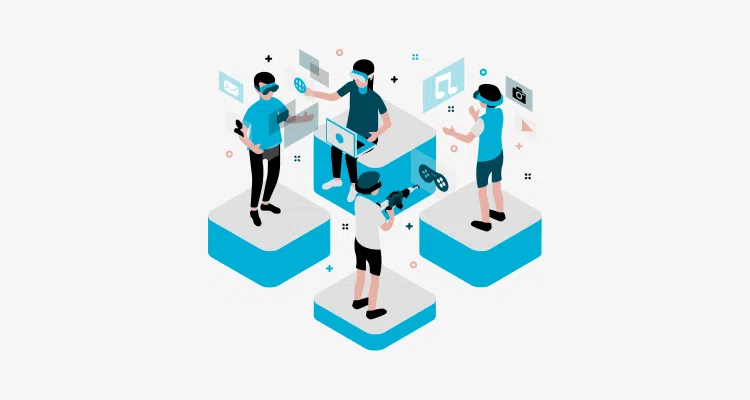The recent buzz of Apple Vision Pro may seem new, with the Alphabet-owned company terming it the “spatial computing” era. However, there is no denying that it is another augmented reality application but an advanced one.
If you are wondering why one of the biggest smartphone brands is venturing into the augmented reality market, the following data will make sense,
- According to Mordor Intelligence, the Augmented Reality(AR) market is set to reach $248.38 Billion by 2029.
- The market is growing at a CAGR of 42.6% and will have revenues close to $42.48 billion by 2024.
- A report from GrandViewResearch shows that integrating AR technologies in smartphones is one of the significant driving factors for market growth.
Such numbers and growing market size have been pivotal in the augmented reality app development boom. Many organizations, including giants like Apple, want to integrate AR applications and functionalities within their systems.
So, if you want to develop an AR application, this article will help you find the best possible framework. But before you start scrolling through the list of best Augmented Reality frameworks, here is a brief introduction to AR.
- The AR market is valued at over $32 billion in 2024, with projections of exceeding $50 billion by 2027.
- As of 2023, there are an estimated 1.4 billion active AR user devices globally, with a projected rise to 1.73 billion in 2024.
- AR glasses market is projected to experience significant growth, with a value reaching $883.4 million by 2025.
- It is estimated that AR Use is continuously rising in all segments. In this regard, the AR Gaming segment achieves the highest value of 7.69 billion U.S. dollars in 2028.

What Is Augmented Reality?
Augmented Reality(AR) continuously integrates the digital information of the user’s environment and surroundings in real time. Augmented Reality apps blend the digital and 3D components, creating a perception of a world environment for the users.
Using AR development, companies can deliver visual elements, sound, and sensory information to users through a device(smartphone or AR/VR glasses).
The term “Augmented Reality” was first coined by Thomas Caudell, an employee of Boeing’s computer services research department. However, the first commercial use of an Augmented Reality application was the yellow first-down marker, televised during the football games in 1998.
Since the first commercial release, Augmented Reality applications have been adopted across domains.
Some of The Top Fields Using Augmented Reality Applications
Whether it’s smart classrooms leveraging AR apps for interactive learning or eCommerce applications enhancing the shopping experience with Augmented Reality technologies, different domains are now adopting this advanced innovation.
Transforming the Way You Learn- AR-based Education
Conventional classrooms are being redefined, leveraging AR apps, adding real-time integrations, and enhancing interactive learning for students. Converting the static images in textbooks into interactive elements has been pivotal for education organizations.
Microsoft has developed Hololens, an AR-based device for medical students and clinicians to access digital information in real-time. It allows doctors and healthcare professionals to superimpose digital data during the diagnosis or surgeries, improving efficiency.
Similarly, many different AR apps in the education domain revolutionize how students learn and interact with digital information. Integration of AR-based technologies in the classrooms can transform the way students interact with study material and enhance the learning experience.
Automation in the Manufacturing Industry: AR-based Prowess
Enterprises across the manufacturing industry are now adopting Augmented Reality applications. One of the most significant uses of AR apps has been in the field of service technical support.
In the conventional approach, a field technician will arrive on the site and examine the issue only to realize there will be a need for additional support.
This also includes needing prior knowledge, experience, or specific details about the support task. Sending additional technicians often becomes costly for enterprises, and this is where AR apps can help.
Technicians can leverage AR-based remote assistance technologies to get real-time data from the site. This helps them provide additional support to the on-site team in real time without being physically present.
Similarly, there are many applications of AR technology in the manufacturing sector, from warehouse management to product line development and real-time quality checks.
AR-based Retail for Enhanced Shopping Experience
AR-based eCommerce development has been transforming the way users shop. For example, virtual try-on features allow users to wear or experience a product virtually. Amazon’s virtual try-on for shoes is one such feature that leverages AR technology to enhance the shopping experience.
Similarly, eCommerce businesses can leverage AR apps to create unique experiences and improve ROI.
AR in healthcare: Changing the way doctors diagnose
Augmented Reality is changing the way medical services are provided to patients and diagnoses happen. For example, in 2020, surgeons carried out the first-ever spine surgery where an AR head-mounted display was used. The 78-year-old patient was diagnosed with a degenerative spine disease which required lumbar decompression.
Surgeons wore an AR headset to visualize the CT scans of patients while operating and placing the implants with 100% accuracy. Since then, many surgeries have been carried out using AR technology, giving surgeons real-time insights into patient’s health.
Each of the above domains, whether education, healthcare, or retail, is leveraging AR technology. So, if you are looking to build an AR app for your eCommerce business or healthcare organization, what will you need?
You may need many things to create an augmented reality app, but the most significant is a frameworks!
Planning mobile development?
Ready to elevate your app development projects? Partner with us for seamless app development solutions.
What Is a Framework?
A framework is a library that simplifies the development process of applications by offering reusable components, tools, and services. Augmented Reality frameworks play a crucial role in AR development by providing pre-built functionalities and features.
These frameworks offer components for tracking and mapping the real world, rendering virtual content, and handling user input. These frameworks allow developers to focus on their AR app’s core logic and user experience without creating basic AR functionalities from scratch.
Frameworks also provide a consistent and standardized approach to augmented reality development, ensuring compatibility and interoperability across different platforms and devices.
Popular frameworks for AR app development include ARKit for iOS and ARCore for Android, which provide a comprehensive set of tools and APIs. However, there are many other Augmented Reality frameworks that you can leverage for your projects.
Popular Augmented Reality Frameworks
Augmented Reality frameworks allow you to seamlessly integrate virtual and physical environments with tools and pre-built features.
1. Kudan
Kudan is a technology company providing advanced SLAM mobile device capabilities through its proprietary GrandSLAM technology. This technology allows for precise image and location-based tracking and has features for 3D object detection.
Kudan offers free and commercial licenses for developers and supports platforms like iOS, Android, Unity, etc. The company is focused on building high-quality consumer and industrial AR applications.
- Proprietary GrandSLAM technology for precise mobile tracking
- Supports both image-based and location-based tracking
- Enables 3D object detection
- Provides both free and commercial licenses
- Focus on high-fidelity consumer and industrial AR apps
2. Apple’s ARKit & RealityKit
ARKit is a development kit created by Apple for iOS devices that enables motion tracking, scene processing, and rendering using device sensors and computer vision algorithms.
RealityKit provides higher-level functionalities for building an Augmented Reality platform with ease; it includes scene understanding, animation, physics simulation, and audio spatialization, among others.
- Uses camera and motion tracking to understand the environment and handle the occlusion of virtual objects.
- Persists virtual objects in a real-world location after the user’s device moves. Anchors can be shared across devices.
- Identifies horizontal surfaces like floors and tables that can be used for placing and interacting with objects.
- Estimates the lighting conditions of the physical environment for realistic rendering of virtual objects and materials.
- Detects the position of people and renders virtual objects so they appear behind real people.
- Provides modular building blocks for organizing objects and their behaviors.
- Position virtual sounds in 3D space based on object positions.
- Build interaction rules using Swift code for things like gestures and animations.
- Anchors can be shared across devices for collaborative experiences.
- Leverages Metal and GPU for real-time rendering of complex 3D scenes.
3. Google’s ARCore
Google ARCore is a software development kit (SDK) for Android’s operating system that allows developers to create augmented reality experiences using powerful APIs to support the functionality of phone applications.
ARCore uses three key pillars to integrate virtual and real-world content: light estimation, environmental understanding, and motion tracking.
- It can detect surfaces like floors, walls, and ceilings to anchor and place AR objects in 3D space.
- Uses the device’s motion sensors and camera to track the position and orientation of the device accurately. This allows AR objects to be placed and move realistically relative to the real world.
- Understands lighting conditions, camera poses, and the physical size of surfaces in the environment for natural rendering of virtual objects.
- Allows users to collaborate and share the location and view of virtual objects across different devices by hosting anchoring data in the cloud.
- Estimates the intensity and color of light in the physical environment so that virtual objects reflect ambient lighting naturally.
- Integrated framework for realistic rendering and tracking of faces to enable Snapchat-like filters.
- Ability to recognize images and trigger AR experiences automatically upon gaze.
- Leverages OpenGL, Vulkan, and GPU acceleration for 60 frames-per-second rendering of complex 3D scenes.
- Cross-platform SDK support for building AR apps across Android and iOS via Unity, Unreal, Android Studio, etc.
- Estimates depth information of the physical scene for effects like occlusion of virtual objects.
- Works across various Android devices without specialized camera or sensor requirements.
4. Vuforia
Vuforia is one of the top Augmented Reality frameworks that access local and cloud-based databases, support virtual reality devices, and provide specific instructions and short tips.
Developers and programmers widely use Vuforia to create AR experiences as part of game design efforts and for specific marketing experiences.
- It can recognize flat images and place virtual objects accurately on them.
- Can also recognize 3D objects and place AR content on them.
- Enables developers to place content on horizontal surfaces in the environment, like tables and floors.
- Offers tracking of various objects and spaces categorized as Images, Objects, and Environments.
- Can recognize many images and frequently update the database with new images.
- Allows developers to record and replay their AR sessions to test, experience, and improve their AR development workflow with the Session Recorder.
5. Unreal Engine
Unreal Engine is a game engine that can also be used as an Augmented Reality framework. It provides a rich, unified framework for building AR apps using the Unreal Engine. Unreal Engine is optimized for extended reality (XR), which includes AR, virtual reality (VR), and mixed reality (MR) technologies.
It is optimized for demanding applications such as AAA games, filmmaking, and photoreal visualization. It is also a founding member of OpenXR, the open VR/AR/MR standard.
- Unreal Engine can recognize flat images and place virtual objects accurately on them.
- It can also recognize 3D objects and place AR content on them.
- Enables developers to place content on horizontal surfaces in the environment, like tables and floors.
- Offers tracking of various objects and spaces categorized as Images, Objects, and Environments.
- Provides extensive support for OpenXR and all hardware vendors’ APIs, from Hololens to ARCore to Oculus.
- Allows developers to create tailor-made XR applications with Blueprint visual scripting or direct C++ coding.
- Provides a wide range of free templates, samples, and a rich library of assets to help developers hit the ground running.
6. Unity3D
Unity3D is a game engine that can also be used as an Augmented Reality framework. It provides a rich, unified framework for building AR apps using the Unity engine. Like Unreal Engine, Unity 3D is also a top choice for game developers who create AAA titles, enabling enhanced AR experiences.
- Unity3D can recognize flat images and place virtual objects accurately on them.
- It can also recognize 3D objects and place AR content on them.
- Enables developers to place content on horizontal surfaces in the environment, like tables and floors.
- Offers tracking of various objects and spaces categorized as Images, Objects, and Environments.
- Supports ARKit, ARCore, and other hardware vendors’ APIs, from Hololens to Oculus.
- Allows developers to create tailor-made AR applications with C# coding.
- Provides a wide range of free templates, samples, and a rich library of assets.
7. Wikitude SDK
Wikitude is well known for supporting various development frameworks, including Cordova, Xamarin, and Flutter. It is constantly updated to meet software developers’ demands, needs, and wants worldwide. It is a powerful tool for creating AR experiences and is optimized for demanding applications.
- Allows tracking of various objects and spaces categorized as Images, Objects, and Environments.
- Offers extensive support for Android, iOS, and other hardware vendors’ APIs, from Hololens to Vuzix.
- Allows developers to create tailor-made AR applications with JavaScript, Native API, and Unity API.
- Can recognize many images and frequently update the database with new images.
- Offers plugins API, camera zoom, flashlight control, and other extended functionality.
8. iOS Arkit
ARKit is an Augmented Reality framework developed by Apple for iOS devices. It was released with iOS 11 at the Apple Worldwide Developer Conference in 2017. ARKit allows developers to create AR apps and take advantage of the hardware and software capabilities of iOS devices.
It is optimized for demanding gaming, shopping, and industrial applications. ARKit is often compared to its Android competitor, ARCore, but ARKit’s performance is much more predictable and consistent due to Apple’s standardized hardware.
- ARKit can understand the user’s environment through scene detection and light estimation.
- Leverages the device sensors like camera, gyroscope, and accelerometer for precise 6DOF tracking of the user’s device motion in real-time.
- Allows placement of virtual objects linked to specific coordinates in the real world. Anchors persist even if the user’s viewpoint changes.
- Supports detecting and tracking some 3D objects like image targets through CoreML integrated models.
- Provides content like 3D models, textures, audio files, and other tools for augmented reality experiences.
- Easily overlays computer vision data and virtual content live on the camera using SceneKit rendering.

Advantages of Augmented Reality
1. Enhanced Experience
Augmented Reality (AR) development enhances user experiences by integrating digital elements into the real world. This creates an immersive and interactive dimension that traditional media cannot match.
Augmented Reality software elevates the sensory perception of the environment, enabling users to experience new facets of reality enhanced with digital overlays, which may include sound, video, graphics, and GPS data.
2. Ease of Use
Augmented Reality frameworks are created to be user-friendly, enabling individuals to easily interact with technology.
By superimposing digital elements onto the real world, Augmented Reality applications facilitate the provision of contextual information in real time, thus simplifying complex operations and improving the overall user experience.
This, in turn, reduces the learning curve and makes technology more accessible to a wider range of audience.
3. Social Interaction
Augmented Reality app offers a highly engaging and interactive platform that can help individuals improve their social skills.
Incorporating AR in group activities and collaborative tasks can encourage communication and teamwork among individuals, leading to shared experiences that bring people together.
4. Learning and Practice
In the field of education, Augmented Reality software can be particularly useful in promoting cooperative learning and enhancing social skills among students.
5. Improved Technology
AR is an ever-evolving technology that continuously improves digital systems. Ongoing research and development have led to more realistic and robust experiences for users, with higher-resolution visuals, accurate tracking, and integration with a growing number of devices and platforms.
Disadvantages of Augmented Reality
1. Privacy and Security Concerns
Augmented Reality (AR) software needs to collect and process a large amount of data, which may include sensitive information.
When AR applications interpret the surroundings of the users, they can unintentionally capture users’ personal data without their consent, which poses a significant risk to privacy.
Storage and transmission of this data can be vulnerable to security breaches, which can result in unauthorized access and misuse of personal information.
2. Issues About Intrusiveness
Augmented reality (AR) technology allows digital content to be integrated into the real-world environment of a user. However, this can sometimes lead to intrusive experiences, especially when the technology superimposes unwanted or distracting information.
This can be particularly concerning in social settings or shared environments where individuals’ preferences for information display and interaction might differ. Such situations could result in a sense of violation of personal space or disturbance.
3. Can Promote Risky Behavior
The use of Augmented Reality (AR) technology may lead users to disregard their physical surroundings, resulting in risky behavior.
For example, users may become too absorbed with AR content while walking or performing other activities, making them unaware of real-world hazards. This distraction could result in accidents or injuries, as users are not fully attentive to their surroundings.
How Much Does an AR Development Project Cost?
The cost of developing an Augmented Reality (AR) project varies greatly depending on a range of factors including complexity, features, platform, design quality, location of the development team, and many other variables.
- Basic AR Applications: Costs for simple AR apps can range from around $7,000 to $50,000. These are generally less complex with fewer features.
- Medium Complexity AR Applications: These applications may include additional features, integrations, or more sophisticated AR capabilities. Costs for these types of apps can range from $50,000 to $150,000.
- Complex AR Applications with Advanced Features: For highly complex AR projects that may involve advanced features such as machine learning, integration with back-end systems, and complex user interfaces, costs can be anywhere from $200,000 to $500,000 or more.
On average, the cost of developing an augmented reality (AR) app can range from $30,000 to $40,000 for a project of moderate complexity. However, it is important to keep in mind that these estimates are general, and actual costs may vary depending on the specific requirements of the project.
Transform your business with app development
Zennaxx, a leading software development firm in Canada, has delivered 700+ bespoke solutions spanning various industries.
Conclusion
In the end, developing an Augmented Reality application comes with several factors to consider right from framework, tools, and cost of development.
However, choosing the right Augmented Reality framework does make a difference because it can impact the development costs.
You can compare these augmented reality frameworks based on features, and alignment with your project requirements.
If you feel stuck and can’t decide, Zennaxx can help you with custom Augmented Reality development solutions. Contact us now to learn more about our AR development services.









